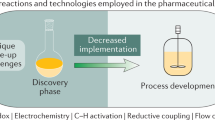Abstract
A protocol for transferring conventional reactions to the microwave field explores the effectiveness of parallel syntheses and combination approaches. Applicability to the reaction systems combiCHEM, multiPREP, MMR8 and HPR is defined. Model reactions have been performed in laboratory equipment.Emphasis is placed on similar reaction conditions in the individual vessels and the repeatability of results. Outcomes include esterifications and multi-center reactions exhibiting a great potential for combinatorial chemistry.
Similar content being viewed by others
References
Ugi, I., Perspectives of multicomponent reactions and there libraries, J. Prakt. Chem., 339 (1997) 499–516.
Schlügl, R., Combinatorial chemistry in heterogeneous catalysis: A new scientific approach or ‘the King's New Clothes?’, Angew. Chem. Int. Ed., 37 (1998) 2333–2336.
Lam, K. S., Lebl, M. and Krchnak, V., The ‘One-Bead-One-Compound’ combinatorial library method, Chem. Rev., 97 (1997) 411–448.
An, H. and Cook, P. D., Methodologies for generating solution-phase combinatorial libraries, Chem. Rev., 100 (2000) 331–3340.
Tommasi, R. A., Whaley, L. W. and Marepalli, H. R., Auto-Chem: Automated solution-phase synthesis and purification via HPLC, J. Comb. Chem., 2 (2000) 447–449.
Ohlstein, E. H., Riffolo Jr., R. R. and Elliott, J. D., Drug discovery in the next millennium, Annu. Rev. Pharmacol. Toxicol., 40 (2000) 177–191.
Ding, Sh., Gray, N. S., Wu, X., Ding, Qu. and Schultz, P. G., A combinatorial scaffold approach towards Kinasedirected heterocycle libraries, J. Am. Chem. Soc., 124 (2002) 1594–1596.
Biginelli, P., Derivati aldeidureidici degli eteri acetil-ed ossalacetico, Gazz. Chim. Ital., 23 (1893) 360–416.
Lidström, P., Tierney, J., Wathey, B. and Westmann, J., Microwave assisted organic synthesis – a review, Tetrahedron, 57 (2001) 9225–9283.
Strauss, Ch. R., Invited Review, A combinatorial approach to the development of environmentally benign organic chemical preparations, Aust. J. Chem., 52 (1999) 83–96.
Larhed, M., Moberg, Ch. and Hallberg, A., Microwaveaccelerated homogeneous catalysis in organic chemistry, Acc. Chem. Res., 35 (2002) 717–727.
Romanova, N. N., Kudan, P. V., Gravis, A. G. and Bundel, Yu. G., The use of microwave activation in the chemistry of heterocyclic compounds (review), Chem. Heterocyclic Comp., 36 (2000) 1130–1140.
Larhed, M. and Hallberg, A., Microwave-assisted high-speed chemistry: a new technique in drug discovery, Drug Discovery Today, 5 (2001) 406–416.
Barchin, B. M., Cuadro, A. M. and Alvarez-Builla, J., Microwave-assisted parallel synthesis of a 2-aryl-1Hisoindole-1,3-dione library, Synlett, (2002) 343–345.
Cotterill, I. C., Usyatinsky, A.Y., Arnold, J. M., Clark, D. S., Dordick, J. S., Michels, P. C. and Khmelnitsky, Y. L., Microwave assisted combinatorial chemistry – Synthesis of substituted pyridines, Tetrahedron Lett., 39 (1998) 1117–1120.
Lew, A., Krutzik, P. O., Hart, M. E. and Chamberlain, A. R., Increasing rates of reaction: Microwave-assisted organic synthesis for combinatorial chemistry, J. Comb. Chem., 4 (2002) 95–105.
Coleman, C. M., MacElroy, J. M. D., Gallagher, J. F. and O'shea, D. F., Microwave parallel library generation: Comparison of a conventional-and microwave-generated substituted 4(5)-sulfanyl-1H-imidazole library, J. Comb. Chem., 4 (2002) 87–93.
Nüchter, M., Müller, U., Ondruschka, B., Tied, A. and Lautenschläger, W., Carrying out chemical reactions in a microwave field, Chem. Ing. Tech., 74 (2002) 910–920.
Nüchter, M. and Ondruschka, B., Organic synthesis with microwaves: there is room for improvement, Nachr. Chem., 51 (2003) 522–526.
Sengutta, U. and Meier, H.-P., Focused Microwave Synthesis, GIT Labor-Fachzeitschrift, (2002) 1038–1043.
Author's team, Organikum, 20th edition, Wiley-VCH, Weinheim – New York, 1999, 519.
Author's team, Organikum, 20th edition, Wiley-VCH, Weinheim – New York, 1999, 442–443.
Kappe, C. O., 100 Years of the Biginelli dihydropyrimidine synthesis, Tetrahedron, 32 (1993) 6937–6963.
Falsone, F. S. and Kappe, C. O., The Biginelli dihydropyrimidone synthesis using polyphosphate esters as a mild and efficient cyclocondensation/dehydration reagent, ARKIVOC, 2 (2001) 1111–1123.
Kappe, C. O., Kumar, D. and Varma, R. S., Microwave-assisted high-speed parallel synthesis of 4-aryl-3,4-dihydropyrimidin-2(1H)-ones using a solventless Biginelli condensation protocol, Synthesis, (1999) 1799–1803.
Perreux, L., Loupy, A. and Volatron, F., Solvent-free preparation of amides from acids and primary amines under microwave irradiation, Tetrahedron, 58 (2002) 2155–2162.
Carta, R. and Loddo, L., Effect of microwave radiation on the acetate-catalyzed hydrolysis of phenyl acetate at 25 °C,Ind. Eng. Chem. Res., 41 (2002) 5912–5917.
Hantzsch, A., Über die Synthese pyridinartiger Verbindungen aus Acetessigäther und Aldehydammoniak, Liebigs Ann. Chem., 215 (1882) 1–82.
Trotzki, R., Nüchter, M. and Ondruschka, B., Microwave assisted phosgenation – alcoholyses using triphosgene, Green Chemistry, 5 (2003) 285–290.
Author's team, Organikum, 20th edition, Wiley-VCH, Weinheim – New York, 1999, 444–445.
Author information
Authors and Affiliations
Corresponding author
Rights and permissions
About this article
Cite this article
Nüchter, M., Ondruschka, B. Tools for microwave-assisted parallel syntheses and combinatorial chemistry. Mol Divers 7, 253–264 (2003). https://doi.org/10.1023/B:MODI.0000006916.69862.3d
Issue Date:
DOI: https://doi.org/10.1023/B:MODI.0000006916.69862.3d




